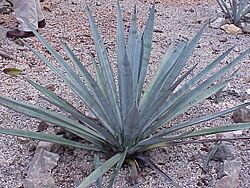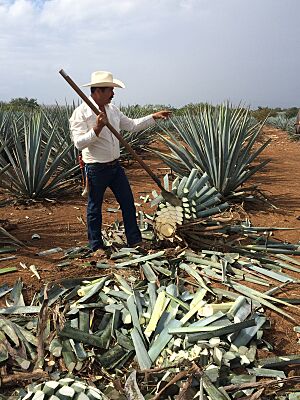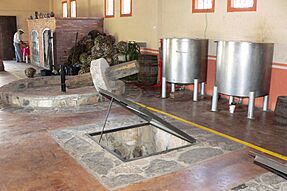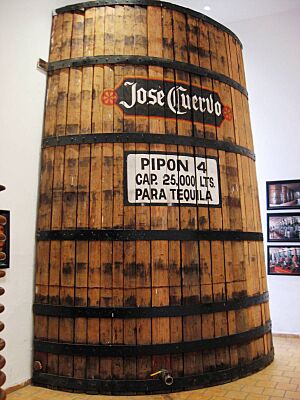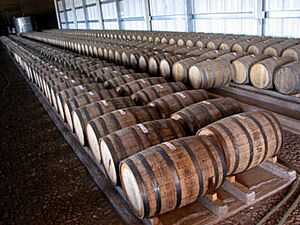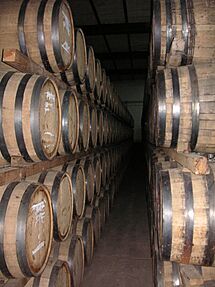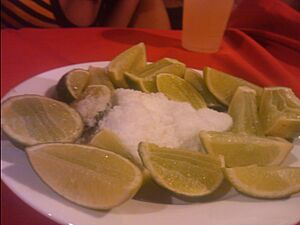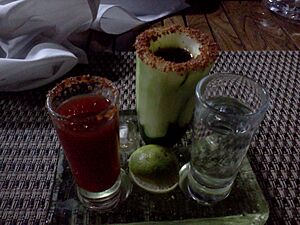Tequila facts for kids
Tequila is a special alcoholic drink that comes from Mexico. It is made from a unique plant called the blue agave. Tequila is famous around the world, especially in Latin America. It usually has about 40 percent alcohol.
Contents
What is Tequila?
Tequila is a type of alcoholic drink known as a "spirit." It is made in specific areas of Mexico, mainly in the state of Jalisco. For a drink to be called Tequila, it must be made mostly from the blue agave plant. This plant is very important to the history and culture of Mexico.
The Blue Agave Plant
The blue agave plant (its scientific name is Agave tequilana Weber Azul) looks a bit like a giant pineapple or a large aloe vera plant. It has thick, spiky leaves that grow from a central core. This core, called a "piña" (which means pineapple in Spanish), is the part used to make tequila.
Agave plants grow best in volcanic soil and warm climates. They take a long time to mature, usually between 7 and 10 years, before they are ready to be harvested for tequila production.
How Tequila is Made
Making tequila is a long process that involves several steps:
Harvesting the Agave
First, skilled workers called jimadores (pronounced hee-mah-DOR-es) harvest the agave plants. They use a special tool called a coa to cut off the spiky leaves. This leaves only the large, round piña, which can weigh from 80 to over 200 pounds!
Cooking the Piñas
Next, the piñas are cooked. This is usually done in large brick ovens or steam ovens. Cooking the piñas turns the starches inside them into fermentable sugars. This step is very important for the sweet flavor of tequila.
Crushing and Juicing
After cooking, the soft piñas are crushed to extract their sweet juice, called aguamiel (honey water). Traditionally, a large stone wheel called a tahona was used for this. Today, many modern distilleries use machines to shred and press the cooked agave.
Fermentation
The aguamiel is then moved into large tanks for fermentation. During this step, yeast is added. The yeast eats the sugars in the juice and turns them into alcohol and carbon dioxide. This process usually takes a few days.

Distillation
After fermentation, the liquid is distilled. Distillation is a process where the liquid is heated, and the alcohol vaporizes and then cools back into a liquid. This step purifies the alcohol and increases its strength. Tequila is usually distilled twice.
Aging (Optional)
Some tequilas are aged in wooden barrels, usually made of oak. This aging process gives the tequila different colors and flavors.
- Blanco or Silver tequila is bottled right after distillation or aged for less than two months. It is clear and has a strong agave flavor.
- Reposado tequila is aged in barrels for 2 months to 1 year. It gets a light golden color and a smoother taste.
- Añejo tequila is aged for 1 to 3 years. It becomes darker and has a richer, more complex flavor.
- Extra Añejo tequila is aged for more than 3 years. It is very dark and has a very smooth, rich taste.
Tequila and Culture
Tequila is more than just a drink; it is a symbol of Mexican culture and heritage. The region where it is produced, especially the agave landscape, is even a UNESCO World Heritage Site. People often enjoy tequila neat, or in popular cocktails like the Margarita.
Images for kids
See also
 In Spanish: Tequila para niños
In Spanish: Tequila para niños



